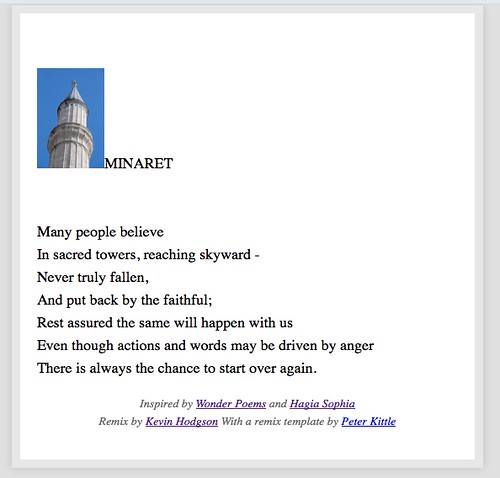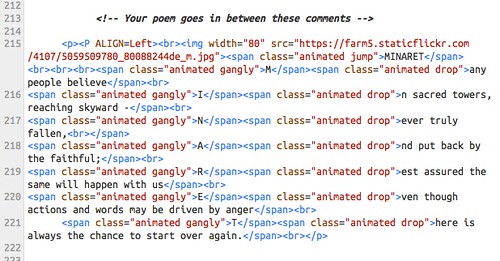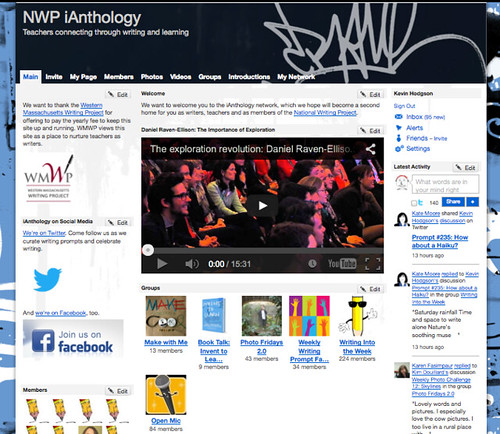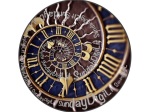I have been invited to talk about technology and youth to a group of mothers (it’s a Mothers’ Club and they are very supportive of our school) in my school district tomorrow night. This presentation will guide my discussions, and I am going to share out this great resource: The Social Media 411 for Parents.
Peace (in the sharing),
Kevin
Category Archives: Technology Resources
DigiLit Sunday: Mozilla Webmaker
I feel like I can’t shout quite loud enough about the resources being developed over at the Mozilla Foundations’s Webmaker space. Here, the philosophy of the “open, remixable web” comes to fruition with a series of projects and tools that invite you to remix and remake in your own light, with tutorials on coding and creating that provide entry points for just about anyone with an interest. Mostly using its Thimble (a webpage-style publishing tool) and Popcorn (a video and digital story tool) platforms, Webmaker offers free and interactive ways to become engaged with digital literacies.
You will need an account with Webmaker to save work (but you can tie it to other email accounts) and I am still navigating the best way for my sixth graders to create work in our environment where they don’t have school emails (ack). But at the very least, you can explore the world of making the web with its remixable templates, and there is the built-in ease of publishing in a matter of minutes just by clicking the “remix” link on any of the projects, tinkering with code and text, and remaking it into something new.
There are also sections at the Webmaker space for how to teach with its tools, where all sorts of “kits” are available for free, and freely remixable for your own situation. You can also use their blank templates for your own lesson plans and ideas.
Go ahead. Remix. Publish. Share. Make stuff and have fun.
Peace (in the open world),
Kevin
Web Literacy Pathways Resource (from Mozilla)
This is an amazing resource about Web Literacy ideas. Click on a skill and see a pathway forward towards new skills that connect back to the original inquiry. (nicely done, Laura Hilliger and other folks at Mozilla). Plus, the whole resource is remixable, so you could revise it for your own audience and purpose.
(Thanks to Mike Downes for the screenshot and for Doug Belshaw for sharing this out)
Peace (along the many paths),
Kevin
Book Review: Writing On the Wall (Social Media – the First 2000 Years)

It really is true: there’s nothing new here. Not with Twitter. Not with Facebook. Not with blogging. Not with any of the social media that we keep saying has “upended” traditional media. In this fascinating look at social media over the past 2,000 years, Tom Standage digs deep into our historical roots to show how the flow of information along social lines has been one constant thread through various phases of civilization.
Writing On the Wall is a fascinating read (and I heard about it from a book review column a friend of mine does at the Boston Globe, where her focus was books about social networking), starting off with Cicero in Rome, asking friends and allies to make sure they sent news of politics and government via notes, complete with comments, delivered by friends, and then moves into the use of pamphlets and scrolls and the printing press and more communication systems from the past that eerily echo the present.
In fact, Standage argues that the media empires that are now starting to fade (ie, newspapers) are the anomaly of history — in that the power to curate information and spread it out fell into the hands of a relative few (ie, publishers and editors and reporters) — and that if you look before and after that blip in time, you can see how prevalent the impact of widespread information is by “the people.”
And all of the same arguments back when Plato was railing against written text (as inferior to oral tradition), and when the Church was railing against Martin Luther and the Reformation Movement, and when the elites in the Arab world were worried about coffeehouse gatherings, and when the King of England was railing against Thomas Paine, and … well, it goes on and on, this railing against the power to publish being put into “the wrong hands” and what information might do to us. Sure, some of what gets published in any space is lies, distortions and more, but when the flow if open and moving, a reader has a better chance of judging veracity and weighing the impact of information, and good will prevail.
Right?
Standage writes:
“…social media is not going away. It has been around for centuries. Today, blogs are the new pamphets. Microblogs and online social networks are the new coffeehouses. Media sharing sites are the new commonplace books. They are all shared, social platforms that enable ideas to travel from one person to another, rippling through networks of people connected by social bonds, rather than having to squeeze through the privileged bottleneck of broadcast media. The rebirth of social media in the Internet age represents a profound shift — and a return, in many respects, to the way things used to be.” (page 250)
Peace (on the wall),
Kevin
PS — here is a talk that Standage gave to Google about social media:
DigiLit Sunday: Poetry Genius
Each Sunday, a bunch of teachers (thanks to Margaret) are sharing out various technology tools that might have value around reading and writing. This week, I thought I would showcase a site called Poetry Genius. It’s part of a collection of annotation tools that include ones around song lyrics. What I like about Poetry Genius is the ability to layer in other media, and if enough folks are adding annotations (which we did during the #walkmyworld project), it starts a conversation about lines and phrases and stanzas.
One of my #walkmyworld poems was this one: Trading Fours on a Saturday Night.
You can embed the projects in other sites:
They have an Educator Genius account for classroom teachers, but the age of students have to be at least 13 years old (although the way around that could be do a classroom collaborative annotation on a whiteboard)
Peace (in the annotations),
Kevin
Animated Acrostic: Minaret
For today’s Wonder Poem about the Hagia Sophia Mosque in Turkey, I chose an animated acrostic, using a Mozilla Thimble template designed by some National Writing Project friends that makes kinetic text poems. I was looking for a way for text to drop out, leaving only the main word in the margins. I think it worked out OK.
Here is the original poem:
Many people believe
In sacred towers, reaching skyward –
Never truly fallen,
And always put back by the faithful;
Rest assured the same will happen with us
Even though actions and words may be driven by anger
There is always the chance to start over again.
Here is a screenshot of my kinetic text poem (but you will need to follow the link to get there):

And here is the code of the poem itself:

What’s nice about Thimble is you can remix the code yourself, too. At the Thimble file, click “remix” and get started (you will need a Mozilla Webmaker account, I believe, but I highly recommend it for all the cool stuff Mozilla is putting together around web design and web composition).
Peace (in the falling words),
Kevin
DigiLit Sunday: Tapestry
My friend, Margaret, hosts a Sunday DigiLit sharing at her blog. She asks us to write about digital writing techniques and tools, so today, I thought I would share out an app that I really like for its simplicity as much as the way a piece of writing can unfold.
It’s called Tapestry, and there is an App and a website. I find myself mostly using the website but I need to explore the App again (as it recently got an upgrade and I am curious). Tapestry works sort of like a series of slides, but you can format text to unfold when a person taps or clicks the screen. So, you hide words and phrases, and let the reader discover the text on their own.
You can add images, too, but I personally like the clean design elements and often keep images to a minimum. Check out Tapestry and let me know how it goes and what you think.
Here is an example that I shared the other day, as I collected haikus from teachers who write with me in the National Writing Project iAnthology space every week:
Peace (in the tap),
Kevin
Infographic: Online Activities of Kids
I’m working on a presentation to a group of mothers in the town where I teach about digital citizenship, and found this infographic by ebuyer that is handy, with useful information about technology use by kids.

Peace (in the sharing),.
Kevin
Into the Catacombs of Time: A MultiMedia Poem
This is part of poetry inspired by the Wonders of the World. Today, Mary Lee has us thinking about the Catacombs of Kom el Shoqafa in Egypt. I wrote a poem, and then decided to use Popcorn Maker to add the visual and audio elements to the poetry.
I descend into the past
down stone steps
past ancient corners
through the rough artistry
of slaves bent on freedom
one floor
two floor
three floors deep
running my fingernails across the wall
as I walk slowly into history flanked by falcons
and the power of the sun into the hearts of men
until I reach the three coffins of rock
in this mound of shards,
wondering all the while whose bones
sleep amid all of this silent chaos.
Peace (in the deep),
Kevin
Staying Closed in the Age of Open

I’ve been having an interesting conversation among some friends about a networking space for National Writing Project teachers that has been active and nurtured for, gosh, at least five or six years now. My friend, Bonnie Kaplan, and I conceived and launched the iAnthology (with initial grant funding and support from NWP) during a time when there was palpable anxiety about writing and sharing online, and so, we built it as a closed community, of sorts. (It was designed to emulate a summer networking site for NWP called the eAnthology, which some of you NWP folks might remember.)
The iAnthology is a Ning site for NWP-affiliated teachers, so we have opened up the homepage but everything else under the hood — all of the participants’ writing and commenting and sharing — is not viewable by the general public. We even made a promise to our participants at the start — this space would be a closed community. Many early participants expressed gratitude that this would be the case, and some noted that they would not have joined otherwise. It was a sign of the times.
In fact, I remember setting up a blog for our Western Massachusetts Writing Project Summer Institute one summer, and somehow, a few of the photos from the private site got archived by Google search (some tech glitch that I never quite figured out), and a teacher whose headshot could now be found on Google was irate and angry, demanding that we call Google and demand that her headshot get removed from any search queries. I was patient with her, and did some research and filed a request, but even then, I knew she was in a hopeless battle against the flow of information. I did feel guilty as the tech person who set up a site that allowed this to happen, though. We had promised privacy and the public had creeped in. It felt like a betrayal of sorts, even though I thought the reaction did not quite merit the offense, but there could have been some underlying story about protecting her identity that I did not know about.
But times have changed, haven’t they? The anxiety among us is not what it used to be. People share everywhere now — on Facebook, on Twitter, with Instagram and Flickr, with YouTube. We’ve since added a Twitter connection to our iAnthology site, and there is a companion Facebook page. We’ve had a group on Flickr, etc. The flow of connections continues to extend outward.
Check out this chart I made about Open Learning a few weeks ago:

Or take part in the Online Learning site, which fosters the idea of wide open spaces for self-directed inquiry. Open learning is everywhere, and changing the face of how we write, connect, share and construct networked communities. It’s become a fabric of our times.
So, our conversations this past week among a few site leaders have revolved around the prospect of opening up more of the iAnthology to public viewing, perhaps, in hopes that we might get more participation. We are also noticing how the seamless connection between platforms (ie, I write here, and share there and there, so that invisible threads connect what I am doing in one space to another space, and you connect with me).
One one hand, I agree with a shift towards “open” and in my heart, I see the merits on many levels. On the other hand, I remember the promise that we built the site upon — the prospect of closed walls — and I think about the stories and writing and images that hundreds of people have shared over the years in a space they assumed was and would be closed, and what it would mean to change the “terms of agreement.”
It feels like Facebook’s dance with privacy, and its claim that open is always better, and that unsettles me. Of course, with Facebook, the “open is better” means “more inroads for advertisements and profits.” We make no money off our writing community, and in fact, the Western Massachusetts Writing Project has funded the Ning for the past few years as a way to support and nurture teachers-as-writers.
And so, my impulse is to keep the site closed and private, although I suspect that if Bonnie and I were to build a writing community today, I would advocate for an open space with many nodes of entry and sharing in a heartbeat. Times have changed. Yet promises are important and trust in one’s word is one of the anchors of any writing community. So I think we will probably remain closed in the age of open.
Peace (in reflection),
Kevin
PS — Are you a NWP teacher or a teacher who has some connection to NWP? Come join us at the iAnthology. We have weekly writing prompts, a Photo Fridays feature, and a shifting variety of activities.


